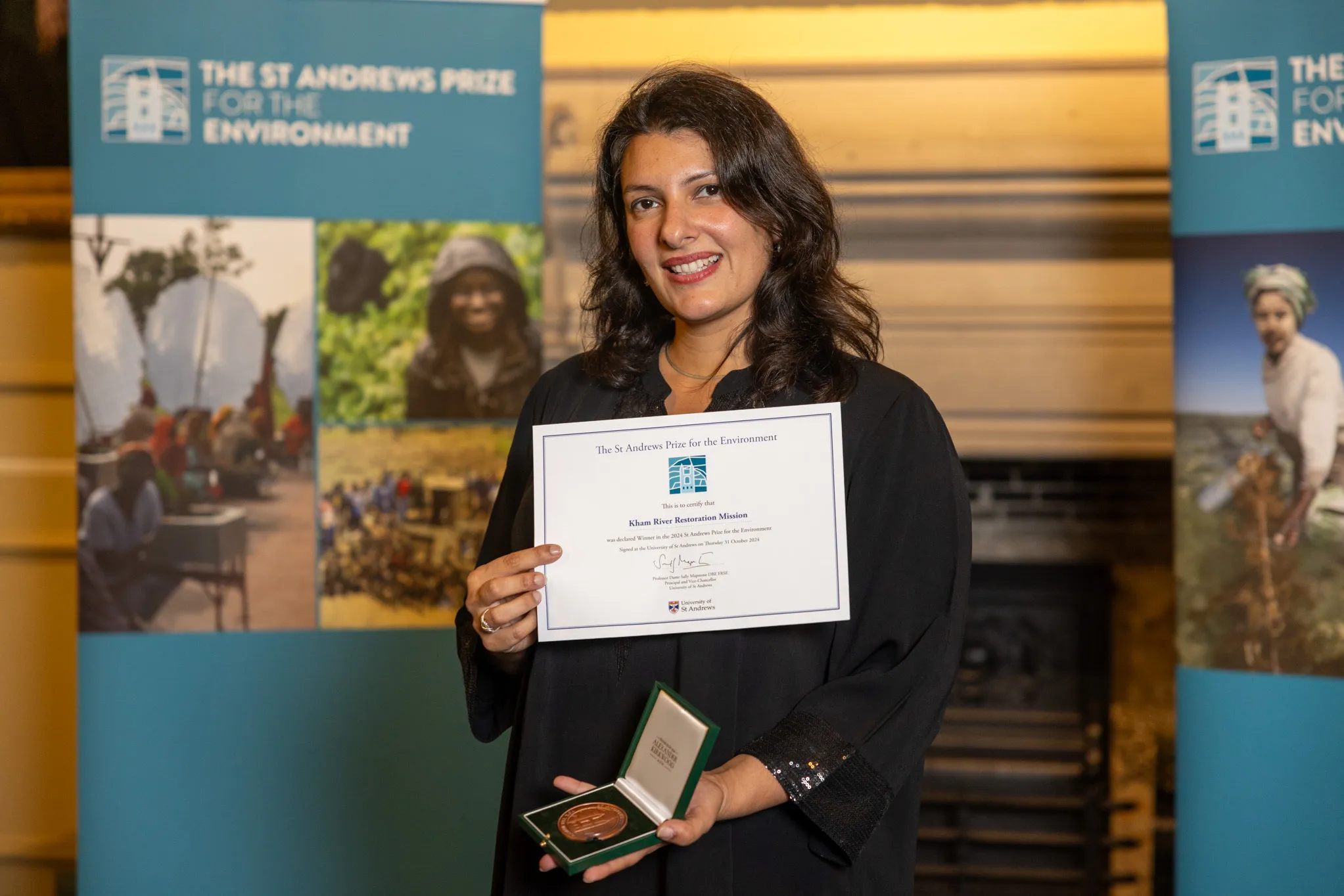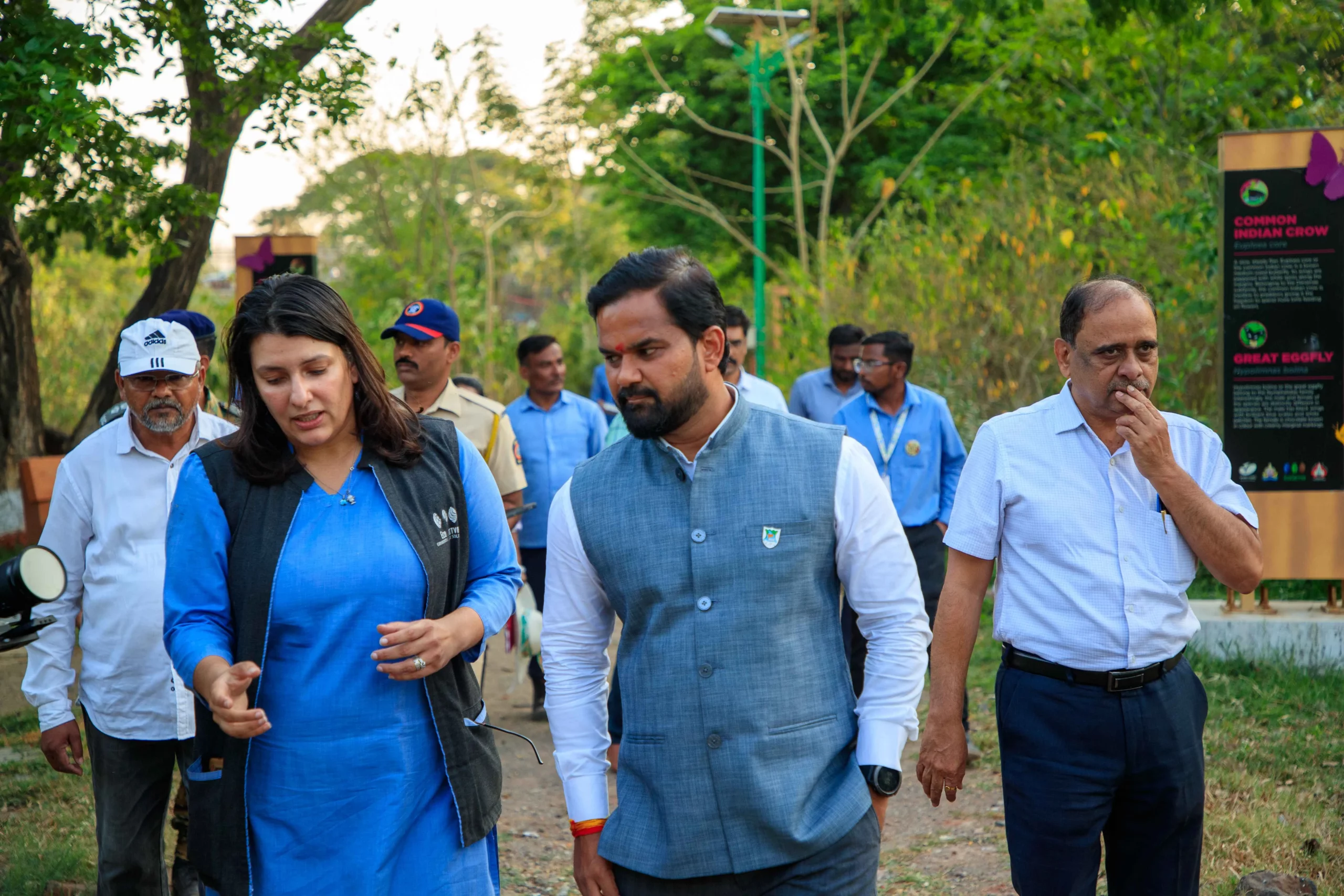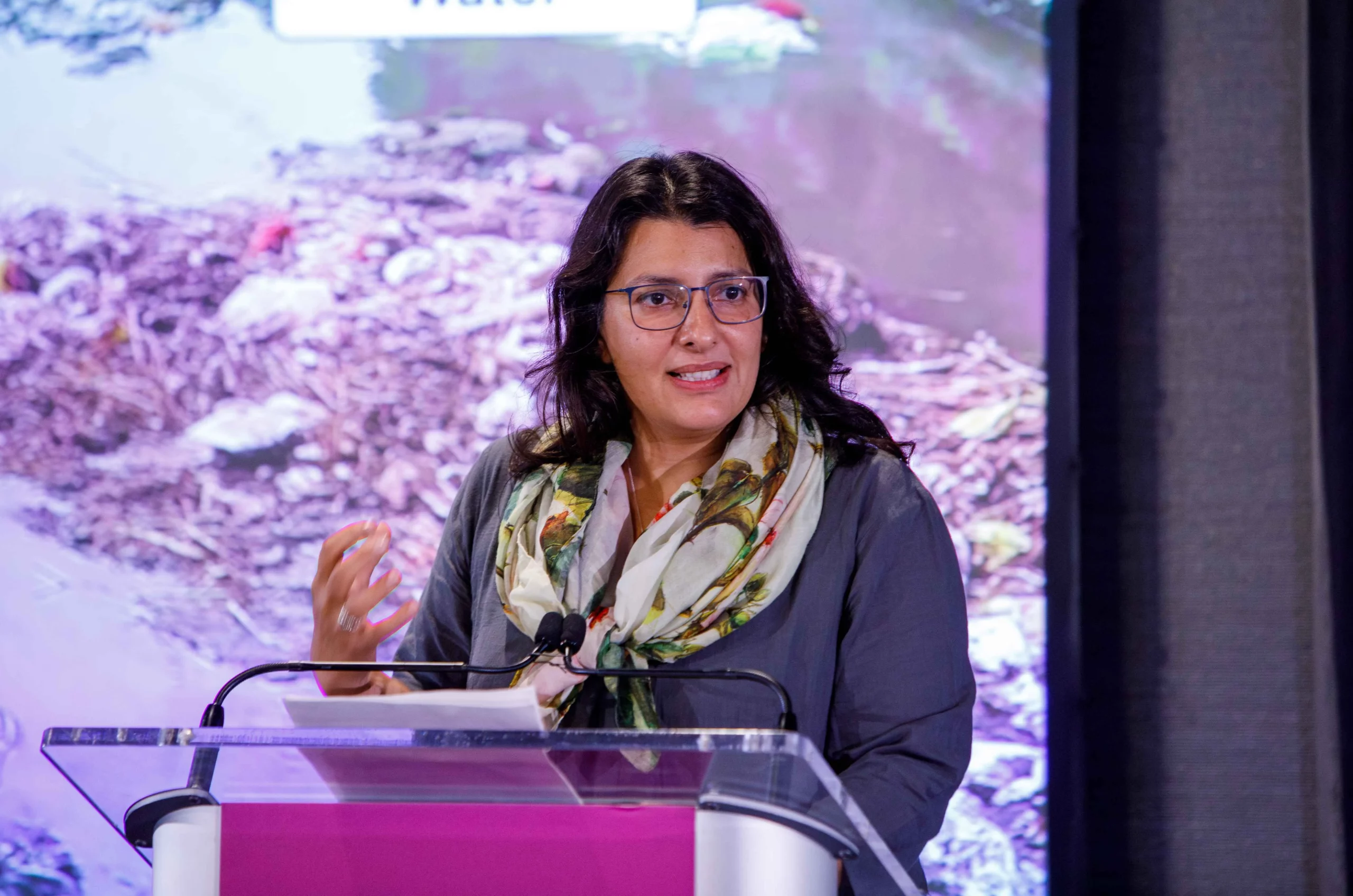(January 16, 2025) Evenings spent splashing around in a nearby stream with her friends are some of Natasha Zarine’s most cherished memories. They would wade upstream through the water, stopping to catch crabs and turtles. Every now and then, they would see little mounds of garbage choke the streambed, and were troubled by it. “Even as kids, we could see that someone was doing something wrong,” Natasha says, in an interview with Global Indian. “Nobody needed to tell us this, even though throwing trash into the stream was the done thing.”
She would discuss it with her mother later, trying to make sense of why people would want to do such a thing. Their own lives were very sustainable and in tune with nature – segregating waste was a routine affair – her family maintained compost pits on the farm, reused plastics and handed over what couldn’t be reused to the bhangarwala when he visited with his pushcart. “He would take all the waste and us a watermelon in exchange,” she smiles. “That was how I grew up and it was pretty normal in a rural setting, too.”
Those carefree days of innocence wouldn’t last. The garbage increased and consumed the little stream, bringing those days of play to an end. And when she went into the cities, she would see even the rivers being choked with trash. “Nobody had a solution or even wanted to create one,” she says.
She may not have been able to save the stream she knew back then, but Natasha has revived many more. She is the co-founder of EcoSattva Environmental Solutions, a social enterprise that provides solutions in solid waste management, green cover management and water body restoration. In 2024, EcoSattva won the WRI Ross Center Prize for Cities and the St Andrews’s Prize for the Environment. Last year, she was part of a cohort of leaders from the Women Climate Collective who were in attendance at the New York Climate Week, in collaboration with the Fondation L’oreal.

Natasha Zarine founder of EcoSattva, received the St Andrew’s Prize for the Environment 2024
Finding her way
Natasha’s path to finding her calling wasn’t easy. Since environmentalism was not an option back in the 1980s, she picked Psychology. By the time she graduated three years later, she was sure it wasn’t something she wanted to pursue.
Feeling a little lost, Natasha decided to take a year off. It so happened that an acquaintance at the time was working at a research centre in the Andamans, and Natasha decided to go, although gap years were very frowned upon back then. There, surrounded by zoologists and botanists and Natasha volunteered with a researcher who was looking at the tree canopy ecosystem. Her days were spent using jumars to shimmy up 20-foot trees and sitting among the branches with notebooks and cameras. When the project’s funding was withdrawn, she found a job as a resident naturalist Havelock Island, where her job was to educate people about the local biodiversity.
She went on to study law, where again, theory differed from practice. Everywhere she turned, she was up against a system rife with malpractice, and success, it seemed, was dependent on being able to turn a blind eye.
“I was in my early twenties, hoping something would make sense, but nothing did,” Natasha says. That changed when a friend encouraged her to apply for the Young India Fellowship. The fellowship was transformative, introducing her to thought leaders like Madhavi Menon and Gill Harris. “It changed the way I looked at things,” she says.
Soon after, Natasha moved to Aurangabad with her husband and began tackling civic issues, particularly waste management. She observed how the same problems existed in both high- and low-income neighborhoods, but the poor always suffered more. “In wealthier areas, garbage was dumped far away. In lower-income areas, the houses were next to the garbage,” she explains. It was clear: she had found her focus.
The waste segregation solution

In Aurangabad, three autorickshaws, one tractor and three staff dealt with solid waste management in a high income neighbourhood with a population of around 2000 people. The lower income area, however, had closer to 10,000 people, with one tractor and one rickshaw that woudl turn up every three or four days. “You could see the stark distribution of resources and how ineffective waste management systems affect people more directly.”
As she worked on finding a solution, networked as much as she could, crossing path with stalwarts like Almitra Patel, the high priestess of solid waste management in India, and with numerous organizations in the same space. Things were set in motion, however, at a conference in Hyderabad, when Natasha crossed paths with Indra Sinha Reddy, the chief officer of a small town around 60 km from Hyderabad. This enterprising officer had actually put a segregation system in place and the small agrarian town he oversaw was spotless. People were segregating, there was effective door to door collection and dry and wet waste were managed separately. For things to change, he told her, you need to be on ground and actually demonstrate how the changes work.
The Civic Response Team
In Aurangabad’s Sindhi Colony, Natasha Zarine and Gauri Mirashi, calling themselves the Civic Response Team, took on solving a mess that no one else seemed to want to touch. They saw a community drowning in waste, where the safaikaramcharis—local waste pickers—only worked sporadically, and garbage collected on the streets, untouched for days. One day, Natasha saw a group of women and children cleaning up the waste and asked, “You do these cleanup drives, so you care… but do you want a real, long-term solution?” The women were eager for change, and Natasha saw a chance to create something lasting.
They started by mapping out the routes for waste collection, adjusting for the reality on the ground. “Route mapping makes sense when you’re pushing a cart with 200 kilos of waste,” Natasha recalled. They repurposed cement rings—originally meant for waste collection—into compost pits, a decision that was met with resistance, particularly from the community. The waste pickers eyed them with suspicion too – “This is our area,” they would say warily. “Why are you here?” But even they came to trust Natasha and Gauri once they saw that their efforts weren’t about taking over their work.
With the backing of Mr. Kendrekar, the local administrator, the project soon expanded. They replaced large tractors with more efficient rickshaws and set up the region’s first Material Recovery Facility (MRF), managed by Ashabhai, one of the original waste pickers. In just four months, the team grew to 27 people, a testament to how far simple, well-planned changes could go.

Natasha Zarine, Co-Founder of EcoSattva Environmental Solutions
The BOTRAM Method
But, as always, progress came with challenges. “The system is constantly in flux,” Natasha said, as leadership changes—like Mr. Kendrekar’s transfer—left the team to rebuild relationships with new officials. Even with these obstacles, their work showed that with the right strategy and determination, lasting change was possible. And soon, neighboring towns began reaching out, inspired by the tangible results they’d seen in Sindhi Colony.
This marked the beginning of what they called the Botram Method, a waste management system built from the ground up. They didn’t rely on pre-existing data—“Nobody really knows what’s going on with waste,” Natasha said. Instead, they went out into the field, collecting their own information: how many vehicles were in use, what resources they had, and where the garbage hotspots were.
In 2018, McKinsey.org set up a team to scout around the world for waste management solutions they could scale up. EcoSattva’s BOTRAM method was one of three solutions chosen. “They wanted us to implement our solution in Bueno Cyrus and Bali and we knew our method was transferable across continents, geographies and languages,” Natasha says. For EcoSattva, it was a chance to standardize their processes, which they are now doing for their riparian restorations too.
Founding EcoSattva
After their success in Sindhi Colony, Natasha and Gauri were approached by a ward officer from a neighboring town, Rahejapur. His request led to a government contract, marking the beginning of a new phase. “We had to register as a for-profit entity and start bidding for contracts,” Natasha explained. That’s how EcoSattva came to be, and their work scaled fast. In Rahejapur, and later in Ratnagiri, their model helped both towns secure five crores each through the Swachh Bharat ranking.
The key, they found was consistency. Some wards had reliable pickup, while others had piles of waste left on street corners. But the true challenge lay in changing the way people thought about waste. “It’s all about getting them to separate it, to compost it,” Natasha explained. But that’s not enough. Shifting perceptions was just one part of the equation. Natasha Zarine and Gauri knew the system had to be constantly monitored and maintained. “Governments spend on infrastructure, but without upkeep, everything falls apart,” Natasha noted.
Cleaning the River Kham
In 2020, Verock Industries approached Natasha Zarine and Gauri to help restore the Kham River, which had long been considered a “gutter.” Once an important water source with a 400-year-old aqueduct system, the river was now polluted by garbage, soil mining, and invasive species. “It’s not just the Kham; it’s the story of feeder rivers everywhere,” Natasha said. The nala system, seasonal rivers meant to feed ponds, lakes, and larger rivers, had become synonymous with pollution. In some places, 62% of people thought it was normal for these nalas to carry sewage.
The team applied their Botram Method to the river, expanding it to tackle both solid waste and water bodies. “We had to restore the riparian zones,” Natasha explained, through planting trees, cleaning the banks, and improving water flow.
Sustainability as a system
As Natasha Zarine and Gauri expanded their work along the Kham River, they started organizing waste collection routes and training local waste pickers, like Renuka, to manage the process. Through their efforts, they helped set up a proprietorship for Renuka and other local workers, offering end-to-end waste management services to villages along the river. “If we set up systems, we can generate jobs,” Natasha said. “People often think job creation happens through infrastructure building, but setting up effective systems is a great way to create sustainable jobs.” This system led to 164 green jobs, empowering locals and improving waste management.
They also realized that long-term success required data. They conducted micro and macro-level research, including orthophoto drone surveys, to map garbage vulnerable points and floodlines along the Kham River—an area where such basic data had never been collected before. “We incorporated the floodlines into the city’s development plan,” Natasha explained. This helped protect the floodplains and stop encroachment, while sewage that had been flowing into the river was diverted to an underground treatment site. “We diverted and treated 4 MLD of sewage,” Natasha said. “And now, fresh water springs are coming up.”
“A space that was seen as a wasteland has become a place for people to meet and interact,” Natasha reflected. But the work was far from easy. “A lot of this has been trial and error,” she admitted. They had to constantly recalibrate their expectations as the challenges of restoring the river became clearer. “What we hoped to achieve and where we’ve landed is not the same,” Natasha said.
Now, they were asked to work on restoring the entire Kham River basin. “To restore the river, you have to fix sewage, waste management, and even agriculture,” she said. They knew the road ahead would be long, but they had seen what was possible with the right system in place. The restoration is being done through the $100,000 monetary award they received with the St Andrew’s Prize.

Natasha Zarine at Kham River basin
New York Climate Week
In August-September 2020, Natasha and Gauri participated in New York Climate Week as part of the Women’s Climate Collective (WCC), a network focused on amplifying the voices of women-led organizations. Natasha reflected on how the experience changed her perspective: “It’s not about how competent you are, but how well you network and build relationships,” she said, acknowledging the challenges women face in a male-dominated space. Through WCC, they gained access to opportunities, including the WRI Rothcentre Prize for Cities and support for attending COP29. “Knowing that an organization cares so much makes a huge difference,” Natasha added. WCC helped her shift her focus, making fundraising a priority and strengthening their ability to advocate for the solutions they knew were necessary.
Follow EcoSattva on Instagram and Natasha Zarine on LinkedIn





